Rotten Tomatoes Are So Lying Again
If yous're 1 of the three million people who planted a abode garden this year, you're nigh probable growing tomatoes. Nine out of x gardeners grow tomatoes, and that number would be 10 out of 10 if the holdouts would taste a fresh garden tomato and compare information technology to a grocery store buy. Nothing beats the taste of a fresh dwelling house-grown tomato!
Many gardeners who abound tomatoes, nonetheless, are frustrated with the progress of their plants. The plant may not set fruit. Or your tomatoes may ripen, but have ugly, spongy black spots at the bottom. Worse still, your plants may await nifty in the evening when you say goodnight to them, but in the forenoon, they're skeletons waving empty branches in the breeze.
Welcome to the world of tomato plant problems. This list of common tomato problems and their solutions will help you place an issue — whether information technology'southward simply starting or already full-blown — and evidence y'all how to correct information technology, then you tin can salvage your lycopersicon esculentum plants and harvest yummy tomatoes this yr.
How to Identify Tomato Establish Issues
Earlier diving into the list, information technology's important for you to correctly identify the problem or tomato plant plant illness. When trying to place tomato plant diseases, utilize these steps:
- Identify the affected part of the constitute— Is it the love apple itself, the leaves, stems, flowers or roots?
- Note differences— When you compare your tomato plant to a healthy establish, how does yours differ? For example, a healthy lycopersicon esculentum has softly fuzzed, medium-green leaves. If the leaves of your plant accept chocolate-brown or black patches, holes, chewed edges or fuzzy mold growing on them, make a note of that earlier perusing the list of problems.
- Look for insects— What insects do you see on your plants? If you need help identifying them, take a photo and contact your local Cooperative Extension agent to identify the insects.
Armed with this information, you can hands scan this list and narrow down the possible tomato institute affliction caused by poor cultivation habits, bacteria, or fungi, plus learn tips on how to fix it. If a disease isn't the issue, then insects may exist the culprit. Check out our list of common tomato pests.

7 Mutual Triggers for Tomato Plant Problems
Diseases, fungi, and sure environmental weather can quickly cripple your plants. Oftentimes, you tin can rescue the love apple with a footling TLC, but some circumstances may require you to destroy it and plant another crop in its place. Here are the nearly common disease and fungus triggers in tomato plants:
- Not plenty fertilizer – Solution: Test your soil and apply fertilizer, like our Safer® Brand Lawn Restore® Fertilizeras appropriate for the growth stage.
- Over-pruning – Solution: E'er utilize a lycopersicon esculentum muzzle and get out enough foliage to shield the fruit.
- Not enough calcium – Solution: Test your soil, utilise lime and gypsum as needed.
- Planting before temperatures heighten to ideal levels – Solution: Look for the right planting fourth dimension for your Hardiness Zone.
- Besides much water or besides little water – Solution: Water them evenly through the growing season.
- Watering overhead, which promotes fungal growths – Solution: Water at the base of operations of the plant. and apply fungicide, like our Safer® Brand Garden Fungicide.
- Lack of air menstruation around plants – Solution: When planting, infinite tomato plant plants at appropriate distance from i another and prune leaves (but not too much, see above) every bit they grow. Use fungicide if powdery mildew appears.
Love apple Plant Issues and Diseases
Armed with the information to a higher place, you can easily scan this list and narrow down the possible love apple plant disease acquired by poor cultivation habits, bacteria, or fungi, plus learn tips on how to fix it. If a affliction isn't the event, then insects may be the culprit. Check out our list of mutual tomato plant pests.

Bloom End Rot
- What it looks like: The tomato plants appear good for you, only as the tomatoes ripen, an ugly black patch appears on the bottoms. The black spots on tomatoes look leathery. When you try to cut off the patch to eat the tomato plant, the fruit inside looks mealy.
- What causes it: Your plants aren't getting plenty calcium. There's either not enough calcium in the soil, or the pH is likewise depression for the plant to absorb the calcium available. Tomatoes need a soil pH around 6.5 in order to grow properly. This soil pH level also makes it possible for them to absorb calcium. Uneven watering habits also contribute to this trouble. Hot, dry out spells tend to exacerbate bloom end rot.
- What to practice about it: Earlier planting tomatoes, accept your local garden center or Cooperative Extension conduct a soil test. They can requite you recommendations to adjust your soil. Lime and gypsum may be added for calcium, just they must exist added in the proper amounts depending on your soil's status. Adding crushed eggshells to your compost pile can also boost calcium naturally when you add compost to the soil. A foliar spray containing calcium chloride can forestall flower cease rot from developing on tomatoes mid-flavor. Utilise it early in the morning or late in the day — if sprayed onto leaves midday, it can burn them. Water plants regularly at the aforementioned time daily to ensure even application of water.
Blossom Drop
- What it looks like:Flowers announced on your tomato plants, just they autumn off without tomatoes developing.
- What causes it:Temperature fluctuations cause blossom drib. Tomatoes need nighttime temperatures between 55 to 75 degrees F in order to retain their flowers. If the temperatures fall exterior this range, blossom drop occurs. Other reasons for flower drop on tomatoes are insect harm, lack of water, likewise much or besides little nitrogen, and lack of pollination.
- What to practise about information technology:While you can't alter the weather condition, yous can make sure the residual of the establish is strong by using fertilizer for tomatoes, cartoon pollinators by planting milkweed and cosmos, and using neem oil insecticides.
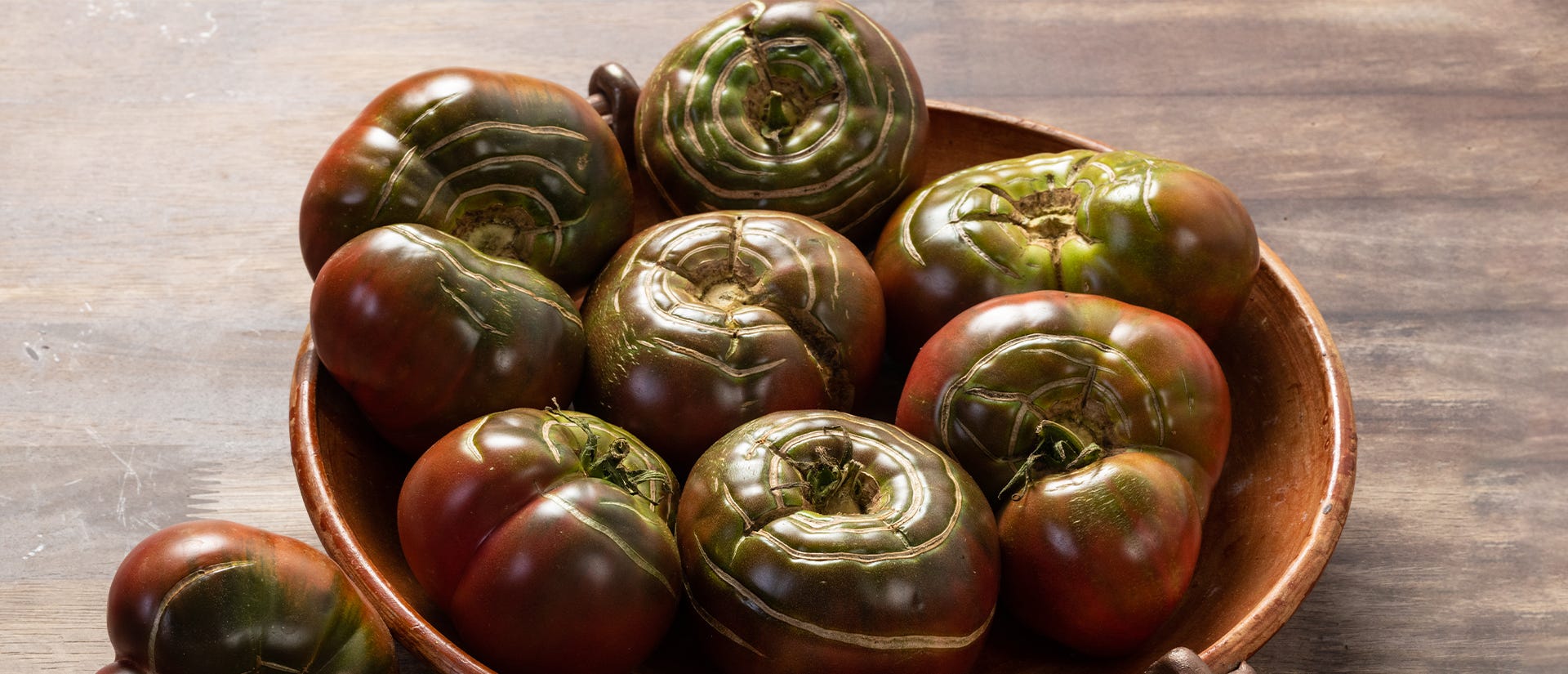
Fruit Cracks
- What they look like:Cracks appear on ripe tomatoes, usually in concentric circles. Sometimes insects use the cracks as an opportunity to swallow the fruit, or birds assail cracked fruit.
- What causes them:Hot, rainy atmospheric condition causes fruit crack. After a long dry spell, tomatoes are thirsty. Plants may accept up h2o rapidly subsequently the commencement heavy rainfall, which swells the fruit and causes it to crack.
- What to do about them:Although you tin can't control the rain, you can water tomatoes evenly during the growing season. This prevents them from beingness so thirsty that they take upward as well much rainwater during a heavy downpour.
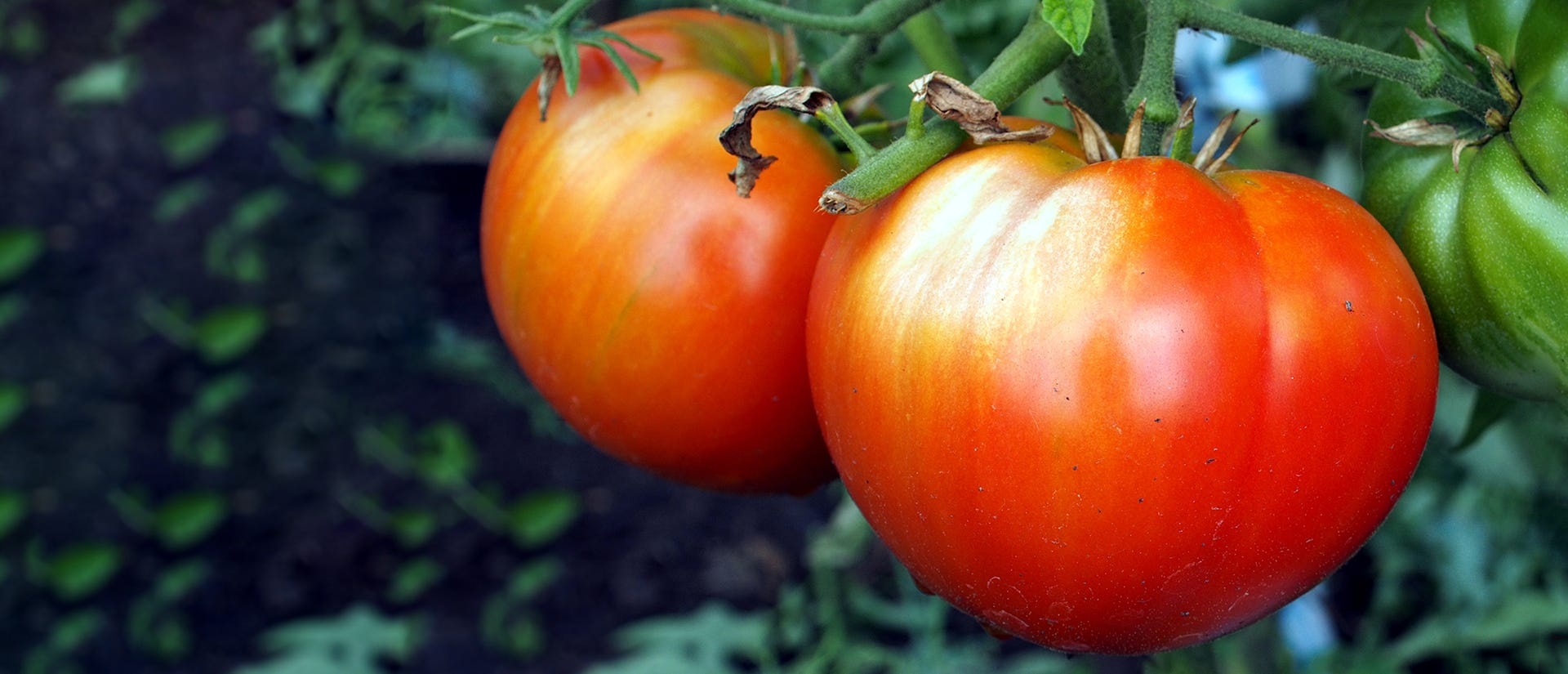
Sunscald
- What information technology looks like:The plants look salubrious, and the fruit develops normally. As tomatoes ripen, yellow patches grade on the red skin. Yellow patches plough white and paper-thin, creating an unpleasant appearance and poor gustatory modality.
- What causes it:Equally the name implies, the sun'southward rays have actually scalded the tomato plant.
- What to do about information technology: Tomato cages, or a wire support system that surrounds the plants, give the best branch support while shading the developing tomatoes naturally. Sunscald commonly occurs on staked plants that have been too-vigorously pruned, exposing many of the tomatoes to the sun's rays. Leaving some leaf and branches provides shade during the hottest part of the day.
Poor Fruit Set
- What it looks like:You accept some flowers but not many tomatoes. The tomatoes you practise have on the establish are small-scale or tasteless.
- What causes it:Also much nitrogen in the soil encourages plenty of green leaves only not many flowers. If there aren't enough flowers, there won't be enough tomatoes. Another cause may be planting tomatoes too closely together. Tomatoes are cocky-pollinating, significant that each flower contains both the male (stamens) and female (pistils) parts. Wind typically pollinates tomatoes, just if plants are too shut together, the wind can't attain the flowers.
- What to exercise about it:Have your soil tested. If you're planting tomatoes in the leap, exit at least two feet or more between plants so that good air circulation can help pollinate them. If your plants are already in the garden, you can simply shake the flowering branches to simulate wind and get the pollen from the stamens to the pistils.
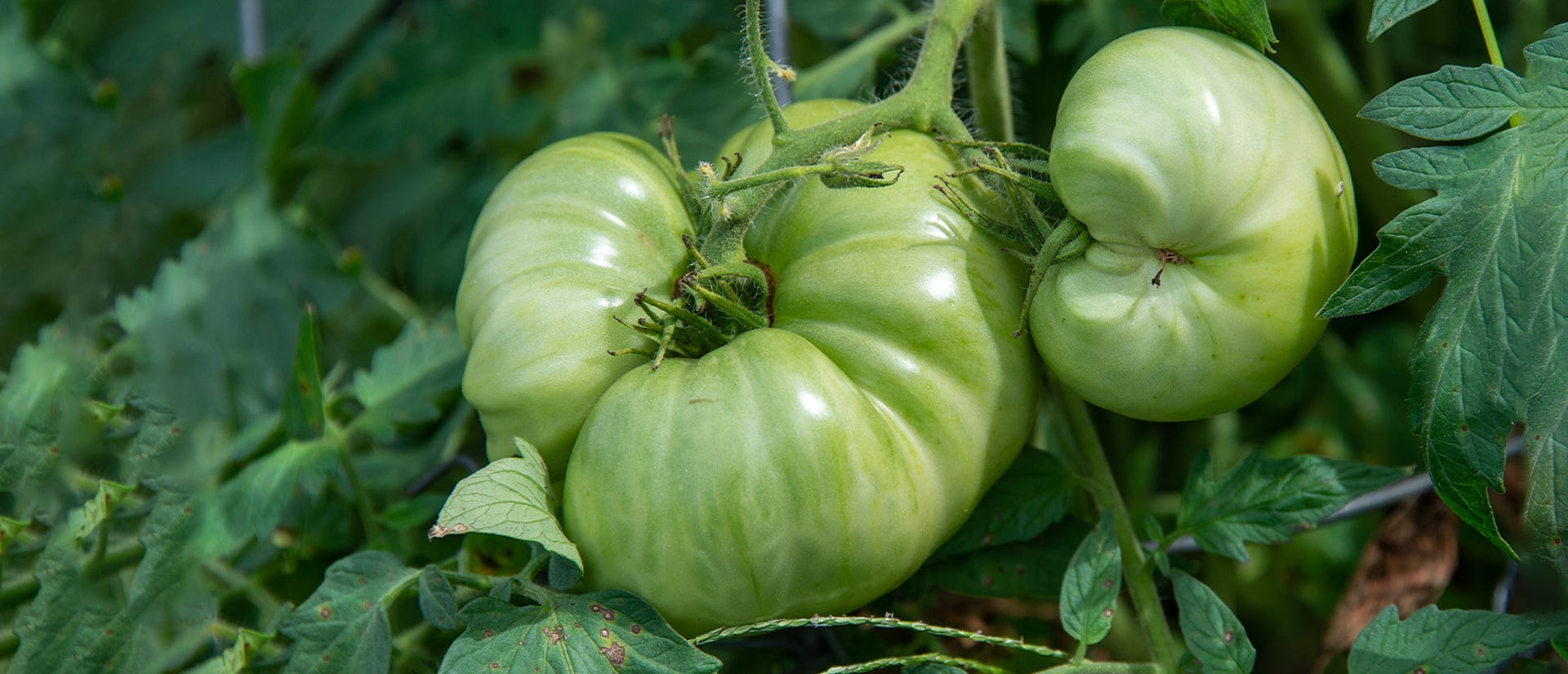
Catfacing
- What it looks like:Catfacing makes tomatoes announced deformed. The bloom terminate is rippled, bumpy and lumpy.
- What causes information technology:Plants pollinated during cool evenings, when the temperatures hover around fifty to 55 degrees F, are subject to catfacing. Blossoms fall off when temperatures drop too low. Yet, if the blossom is pollinating before the petals brainstorm to drop off, some stick to the developing tomato. This creates the lumps and bumps typical of catfacing.
- What to practice nigh it:If possible, constitute tomatoes a little later in the season. The weather should exist warm enough to support proper tomato evolution. Devices such every bit a "Wall of H2o" can aid keep temperatures loftier enough on common cold nights to prevent cold-related problems. Using black plastic on the soil tin also help. The plastic heats during the day and releases the heat back towards the plants at nighttime. Use until the temperatures warm up enough that it's no longer needed.
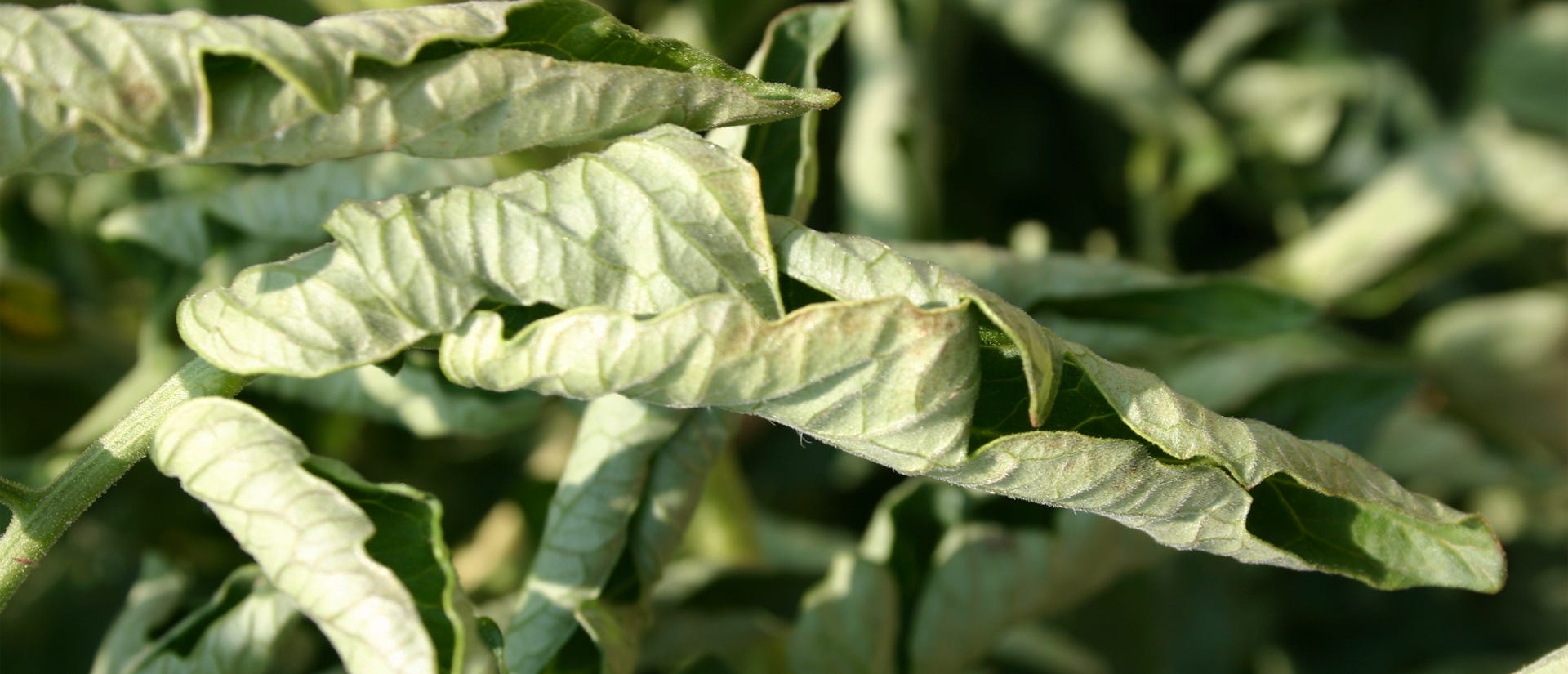
Leaf Gyre
- What it looks similar:Mature lycopersicon esculentum plants suddenly curl their leaves, peculiarly older leaves nigh the lesser. Leaves ringlet up from the exterior towards the center. Sometimes up to 75% of the establish is affected.
- What causes it:High temperatures, wet soil and too much pruning often result in leaf roll.
- What to practice about it:Although it looks ugly, leaf whorl won't affect tomato plant development, so you will however get edible tomatoes from your plants. Avoid over-pruning and make sure the soil drains excess water away.
Puffiness
- What it looks similar:The tomato plants look fine, they flower co-ordinate to schedule, and ripe ruby-red tomatoes are set for harvest. When the lycopersicon esculentum is sliced, the interior has large, open up spaces and not much fruit within. Tomatoes may experience light when harvested. The outside of the love apple may have an angular, square-sided look.
- What causes information technology:Under-fertilization, poor soil diet or inadequate pollination.
- What to do about it:Make certain you are feeding your lycopersicon esculentum plants throughout the flavor. A counterbalanced fertilizer such as a 10-10-10 should exist fed biweekly or monthly. Tomatoes are heavy feeders and need fertilizer throughout the growing season. For gardeners, frequent top-dressings with bootleg compost and compost teas are a must.
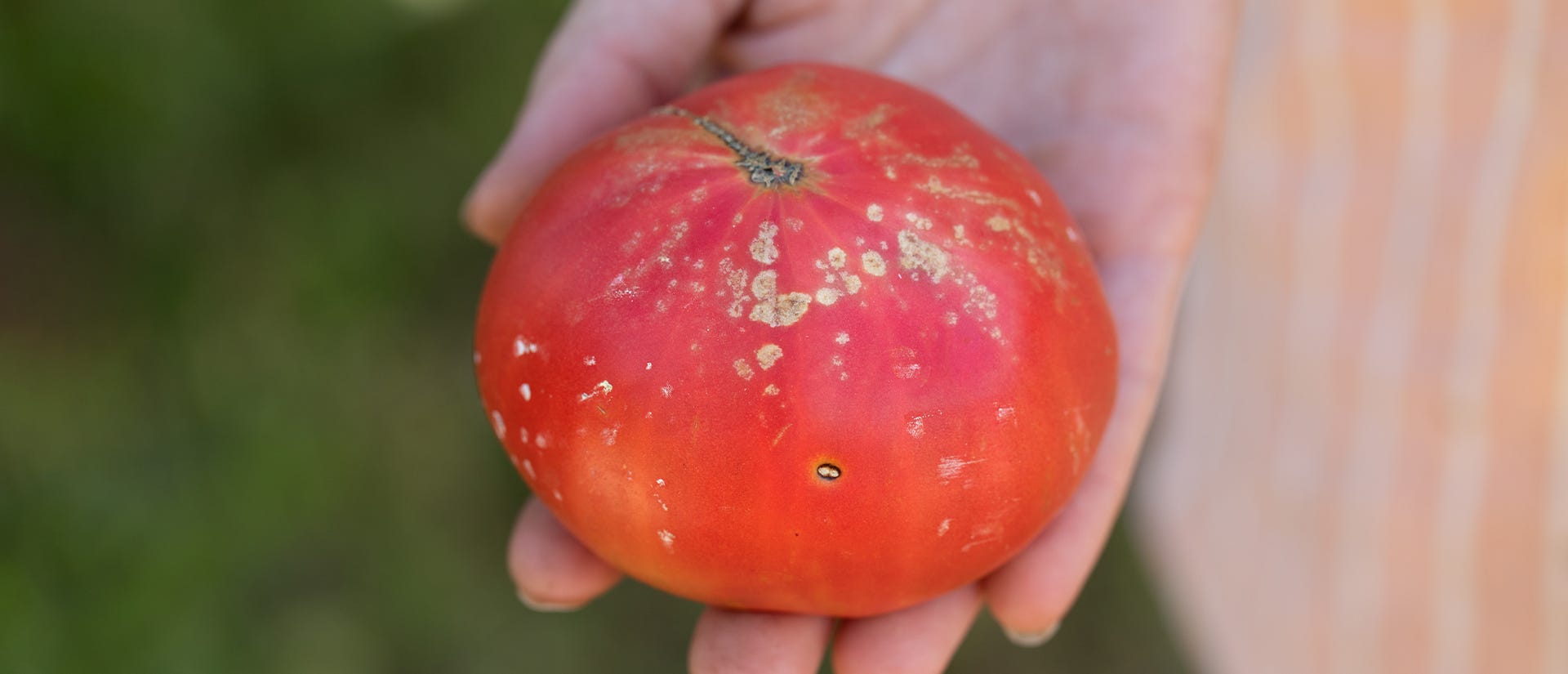
Bacterial Herpes
- What it looks like:Frequently confused with cloudy spot disease, bacterial cankers start as xanthous dots on ripening red tomatoes. If you lot look carefully at the spots — using a magnifying glass if you have 1 — you'll come across a dark, birds-center-type rim around each of the yellowed spots. This is what distinguishes bacterial herpes from cloudy spot disease.
- What causes it:A bacteria calledClavibacter michiganensis.The bacteria occurs naturally but can exist brought into the garden on infected plants or tools. One time it gets into the soil, rainwater splashes it up onto the plants. If there's an open sore, such every bit insect damage or a leaf missing from pruning, information technology can enter the plant and infest it.
- What to do well-nigh information technology:Remove the infected plants immediately and do not plant tomatoes over again in that soil for at least three years. Rotate your crops regularly to forestall these and other diseases from taking hold in the soil. Don't compost the dead plants — instead, put them in the trash to avoid spreading the bacteria.
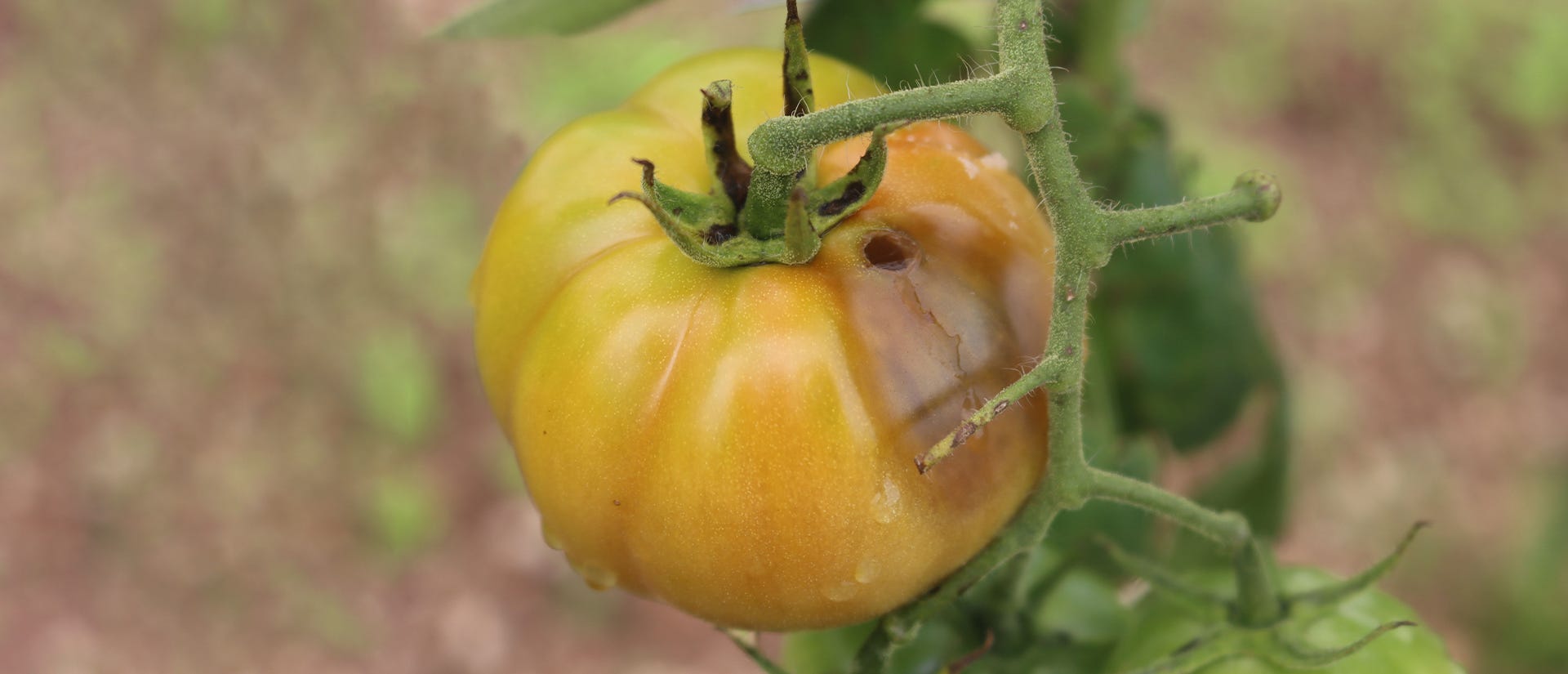
Anthracnose
- What it looks like:As tomatoes ripen, a night, bull's-eye circumvolve appears on the blossom end or lesser of the lycopersicon esculentum. The spot is sunken and mushy to the touch. When you slice into the tomato plant, there'south a black mushy spot underneath that looks similar rot.
- What causes it:A fungus calledColletotrichum phomoides.The mucus loves hot, moist weather and is often spread by overhead irrigation, sprinklers striking infected soil and splashing the mucus upwards onto the plants, and infected plants.
- What to exercise most information technology: Switch your watering methods so h2o drips on the roots, not the leaves of the plants. Harvest tomatoes when ripe, since overly ripe tomatoes tend to contract the mucus more tomatoes in the early stages of ripening.
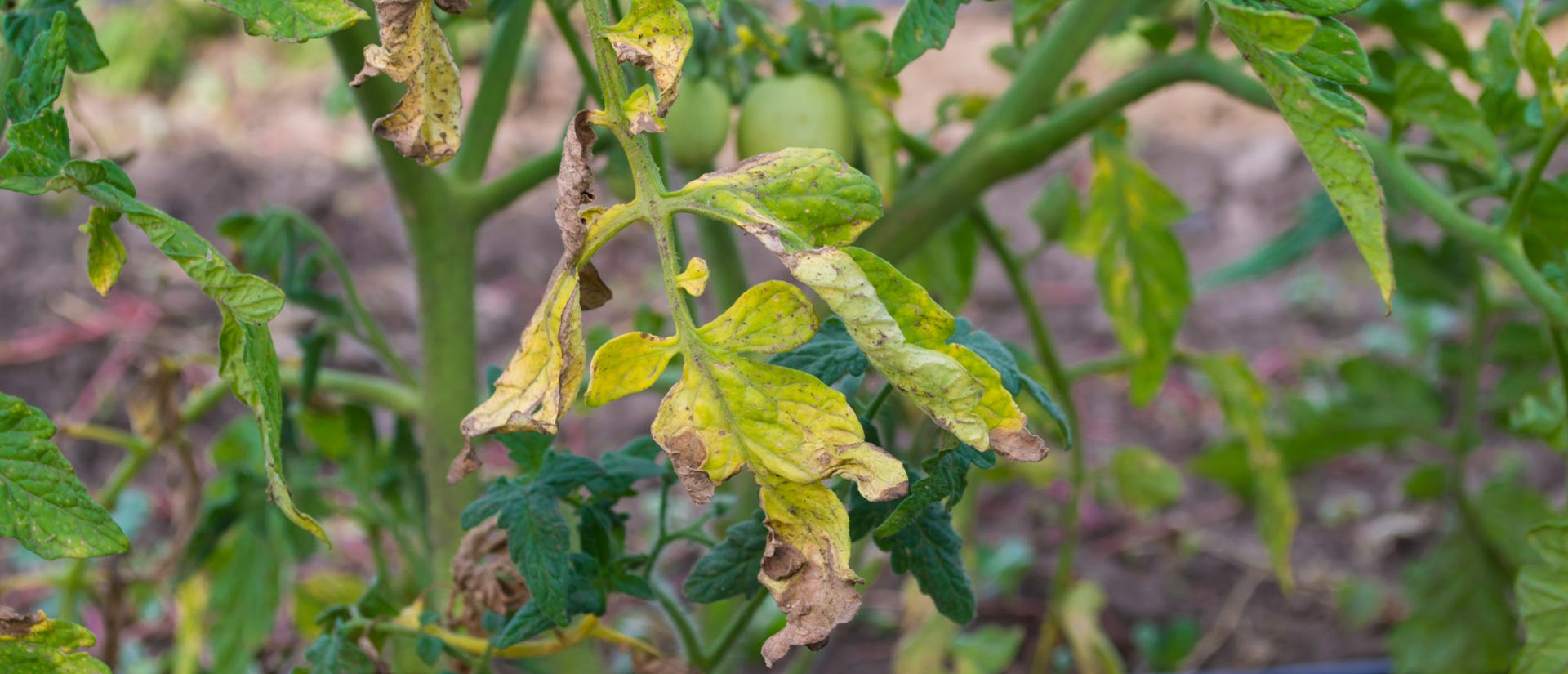
Early Blight
- What it looks similar:You'll find dark-brown spots on tomato leaves, starting with the older ones. Each spot starts to develop rings, like a target. Leaves plow yellow around the brown spots, then the entire leaf turns brown and falls off. Eventually the plant may have few, if any, leaves.
- What causes information technology:A fungus calledAlternaria solani. This fungus can live in the soil over the winter, and then if your plants have had problems earlier like this, and y'all've planted tomatoes in the exact same spot, chances are good the same affair will happen to your plants this year.
- What to exercise near it:Crop rotation prevents new plants from contracting the disease. Avoid planting tomatoes, eggplants or peppers in the aforementioned spot each year as these can all be infected with early bane. A garden fungicide can treat infected plants.
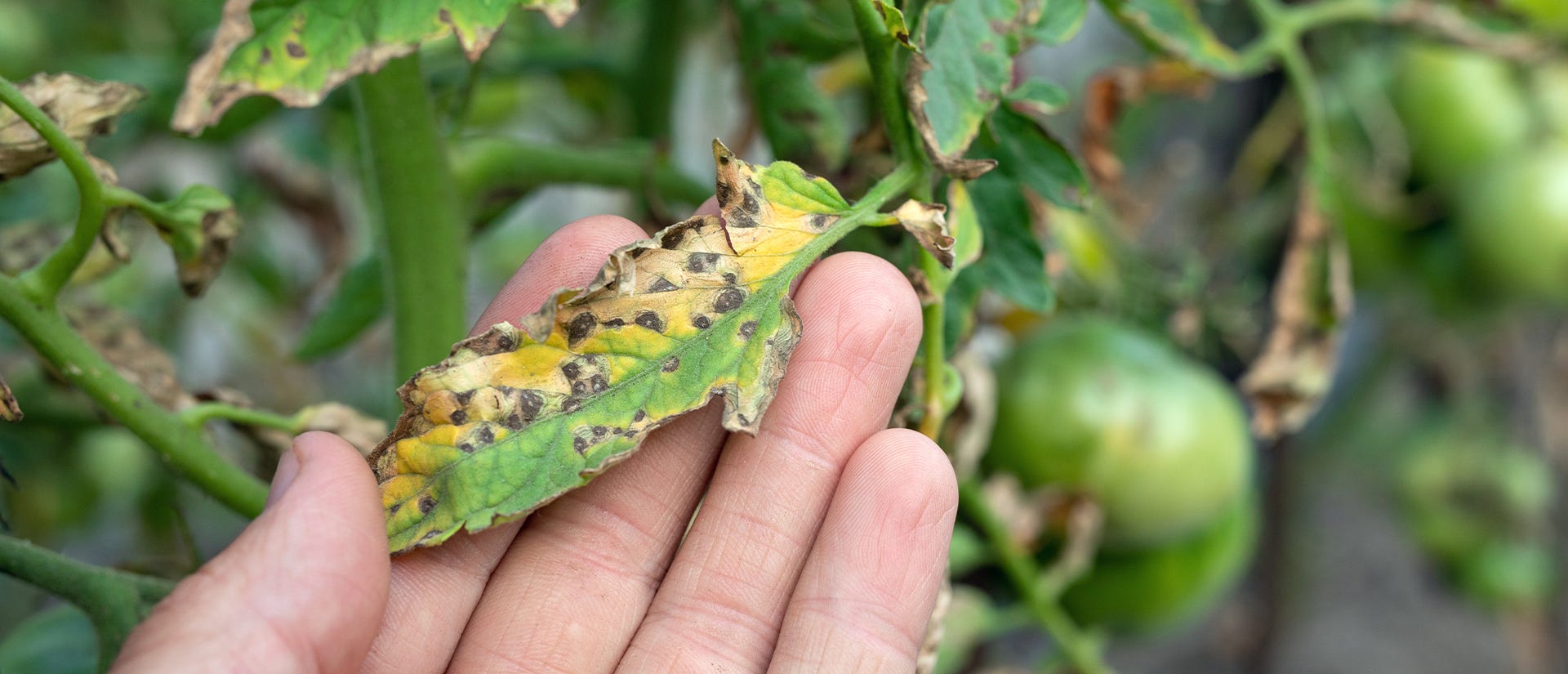
Septoria Leaf Spot
- What it looks similar:Later the plants brainstorm to develop tomatoes, the lower leaves pause out in xanthous spots. Within the yellow spots, nighttime gray centers with dark borders appear. Blackness dots announced in the eye of the spots. Foliage dies and falls off.
- What causes it:A mucus calledSeptoria lycopersici that infects foliage.
- What to do about it:Avoid watering tomatoes from the top, as the spray tin can force the spores developing on the leaves back into the soil and keep the affliction bike. Use a spray that fights fungal diseases, such as Safer® Brand 3-in-1 Garden Spray.
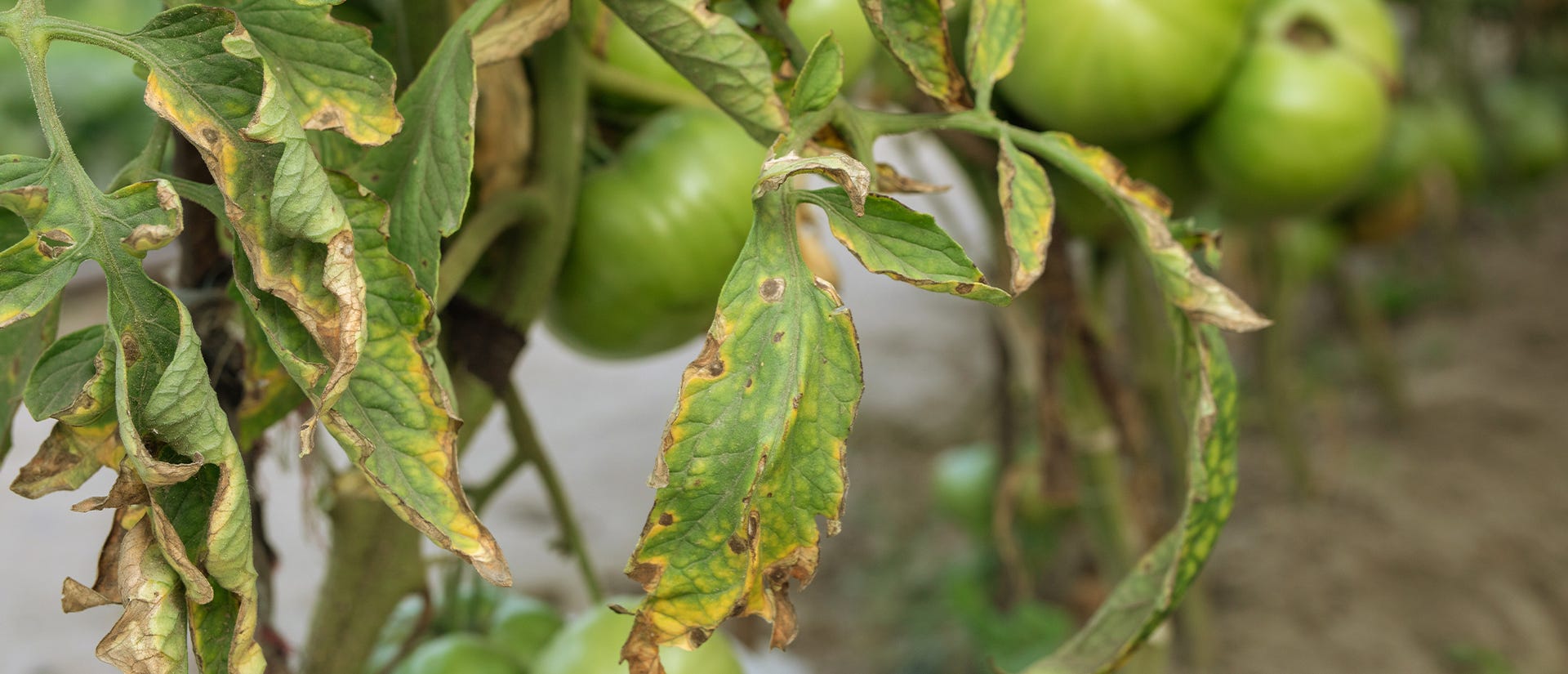
Fusarium Wilt
- What it looks like:Your lycopersicon esculentum plants await fine, when suddenly, they start to wilt. At first, only one side may exist affected, but then the whole plant is wilting. You h2o them, and the problem gets worse. Within a day or two, the plant is dead!
- What causes it:A nasty fungus calledFusarium oxysporum f.sp. lycopersici that attacks the vascular arrangement of the found, roughly equivalent to a human's veins. The fungus destroys the xylem tubes, which ship water and nutrients upward from the roots and into the leaves.
- What to do about information technology:In the case of fusarium wilt, the best defence force is a good law-breaking. Rotate your crops so tomatoes aren't planted in the same section of the garden each yr. Buy wilt-resistant varieties if yous've lost tomatoes to wilting diseases in the past, since the fungus tin overwinter in garden and lawn soils.
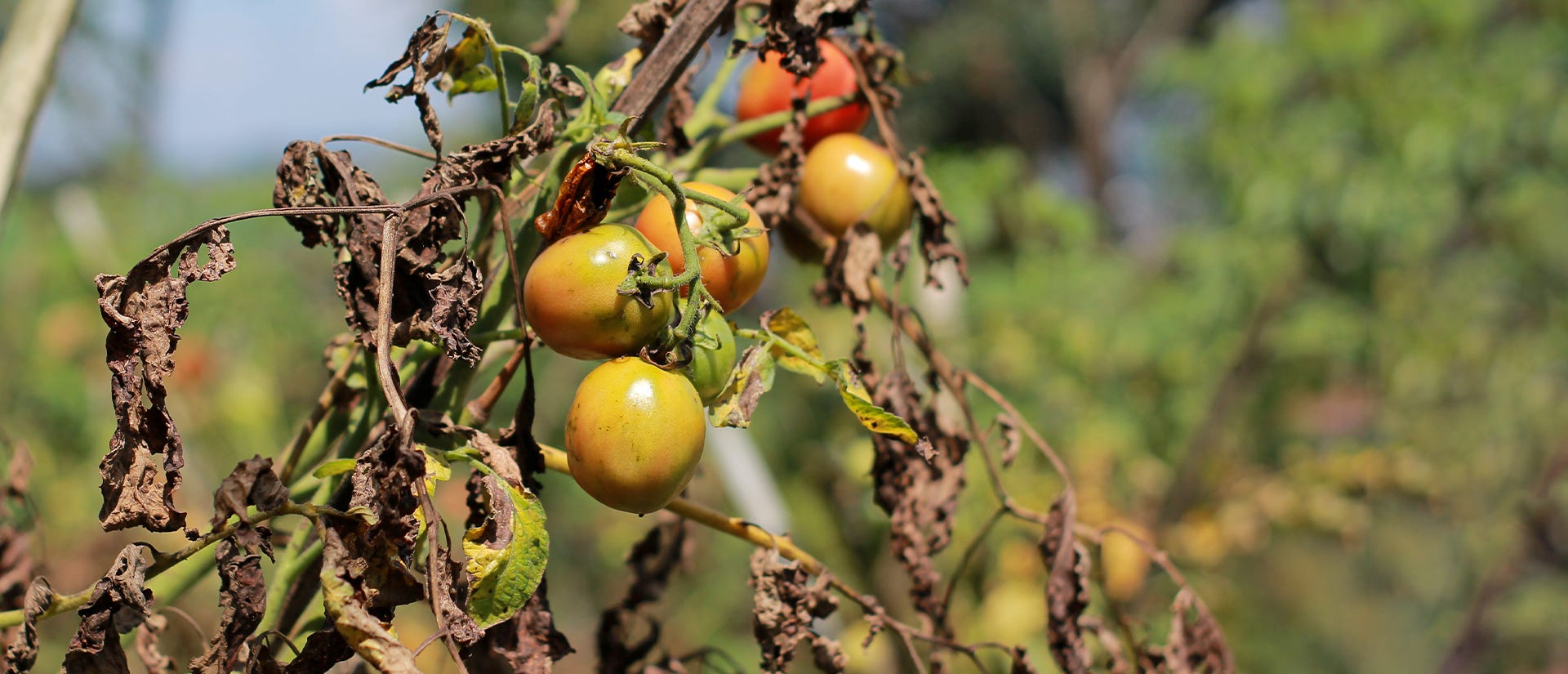
Verticillium Wilt
- What it looks like: Yellow blotches appear on the lower leaves. Every bit the blotches spread, the veins in the leaves turn brown. After the leaves plough chocolate-brown, they autumn off. The disease progresses up the stalk until the plant is stunted.
- What causes it:A fungus that lives in the soil,Verticilliurn albo-atrum, attacks the roots and travels upwardly the xylem tubes with water. It and then prevents the normal flow of water and nutrients to the leaves.
- What to do nigh information technology:Once plants are infected, there isn't much you tin do to treat Verticillium wilt. Rotate your crops, because the fungus can live for long periods in the soil and even live among weeds such as ragweed. Choosing wilt-resistant varieties to plant is the all-time mode to prevent Verticillium wilt.
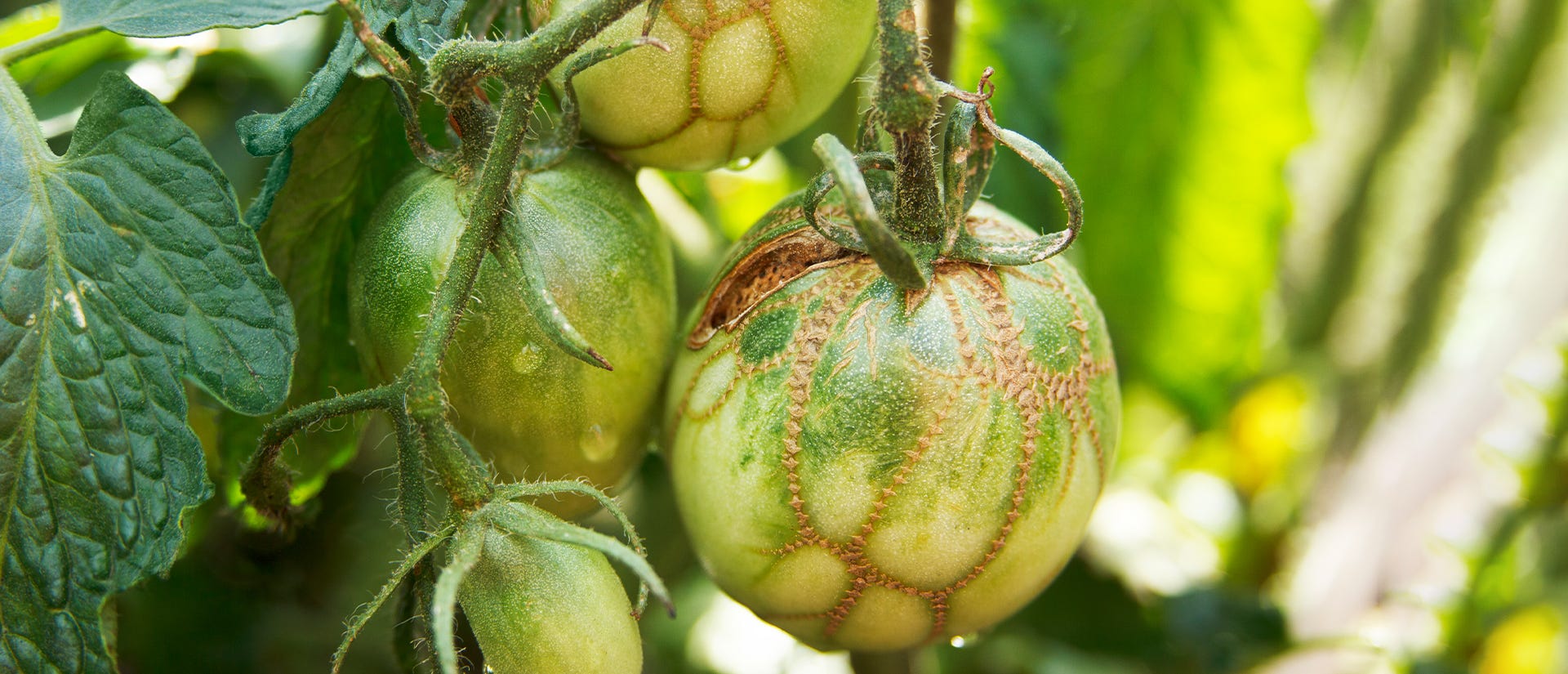
Viral Diseases
- What they looks like:Viral diseases mainly set on the tomatoes themselves. Yous might find black spots on tomatoes, or weird stripes on them. Don't confuse signs of disease for just how some heirloom tomatoes look with natural stripes.
- What causes them: Many of these viruses spread when plants are stressed by heat, drought or poor soil.
- What to do about them:If yous've read through all of these tomato issues and think your tomatoes may be suffering from a viral disease, spray your lycopersicon esculentum plants with neem oil. Good soil management and using organic fertilizer for tomatoes helps keep your plants salubrious, which can help them naturally resist viruses better.
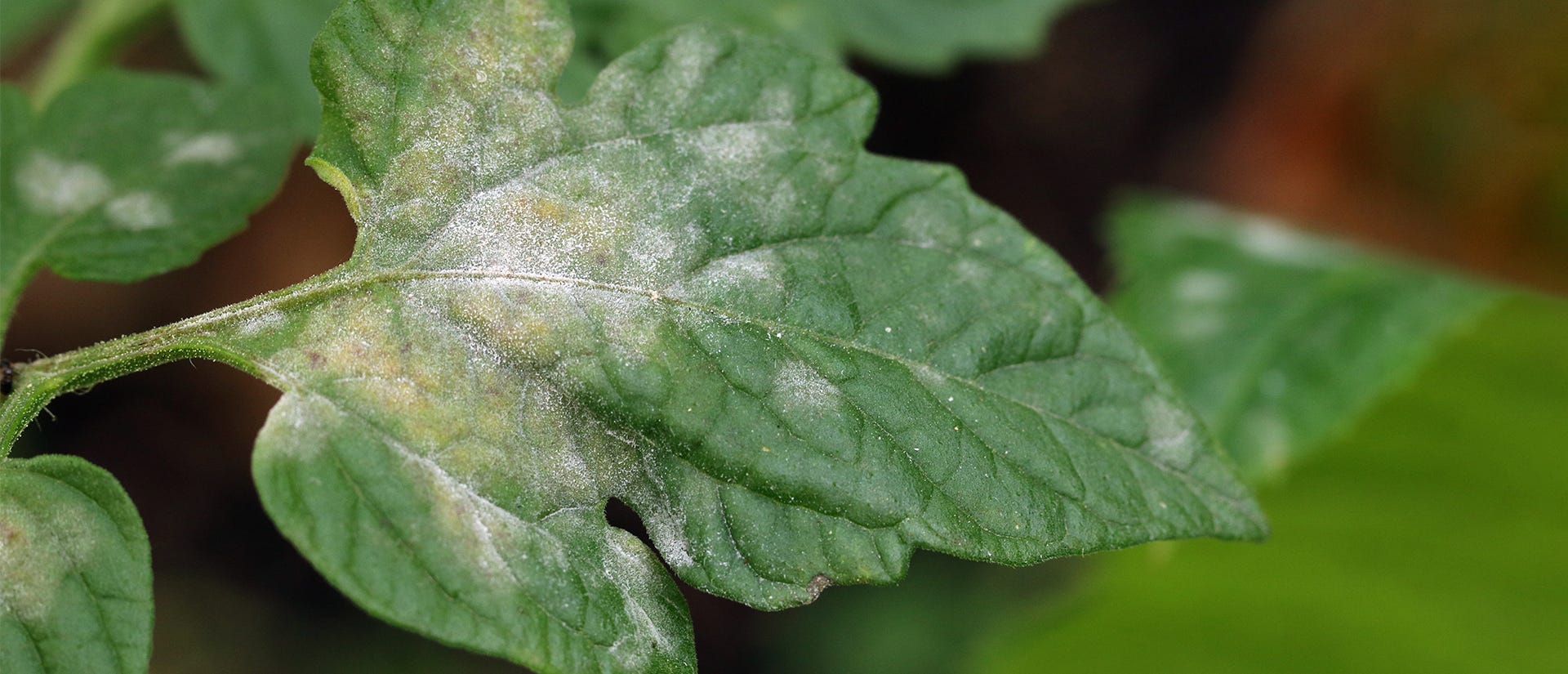
Powdery Mildew
- What it looks similar:Powdery mildew is easy to detect on tomato plants as it looks similar someone brushed the leaves with a white powder. You might find white spots on tomato leaves or even the stem. If you let the fungi thrive it volition turn your love apple leaves yellow and then dark-brown.
- What causes it: Powdery mildew on tomatoes is more common in greenhouses than an outdoor garden because of the lack of air flow and high humidity.
- What to do about it:The all-time way to forestall powdery mildew on tomato plants is to use a preventative spray formulated with sulfur. For more information, read this mail service on prevention and treatment of powdery mildew on plants.
Tell United states Near Your Tomato Bug
Join the Safer® Brand Community on Facebook, where we want to come across the pictures of your tomato and garden bug. When you upload a photo or inquire us a gardening question, we'll go on the example and offer suggestions for your adjacent steps. Likewise, be certain to subscribe to the Safer® Make E-Newsletter – signing upwards gives you links to helpful manufactures similar this one.
Source: https://www.saferbrand.com/articles/common-tomato-plant-problems-how-to-fix-them
0 Response to "Rotten Tomatoes Are So Lying Again"
Enregistrer un commentaire